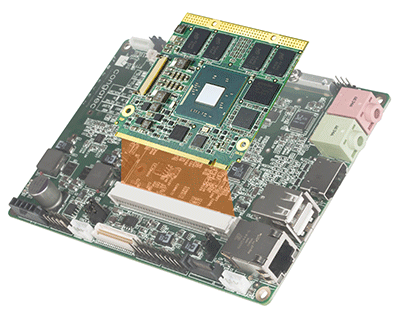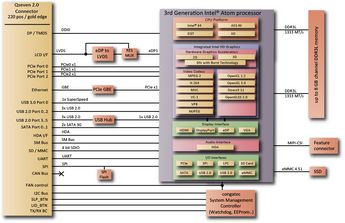A Duel of Atoms – Qseven vs COM Express Mini
When Intel launched the first generation of the Atom processor Z500 series (codenamed Silverthorne), it represented a major step forward in terms of multimedia features in compact and mobile applications with X86 architecture. In the consumer market, it led to the emergence of Atom Inside netbooks, later to be replaced by the first tablet PCs and smart phones. In the industrial environment, advances were just as exciting with increasingly smaller ITX single board computers and the introduction of new computer module standards such as Qseven and COM Express Mini for specific applications. With the launch of the new generation of Atom processors (codenamed Bay Trail), it is time for a fair comparison between these two computer module standards.
Advances in Atom technology
With the addition of some well-known Core i processor extensions, such as out-of-order execution for faster chain of command execution plus modern and competitive graphics with DX11 and OpenGL 3.2 support, Intel’s new Bay Trail Atom and Celeron processors are technologically back on trend. The new feature sets and options bring them significantly nearer to the Core i series and close the performance gap.
With manufacturing based on the latest 22nm tri-gate transistor technology, production costs and power consumption are both reduced while performance remains competitive. According to Intel, the same power consumption yields three times greater performance, while achieving the same performance requires only one-fifth of the power consumption of previous Atom processor generations. This means that the computing power per watt is even greater than with the latest ARM processors. For the first time, the Atom and Celeron processors are now also available as quad-core processors. These extend the range of the previous dual-core processors with hyperthreading, which is no longer available for the new processors. The updated Turbo burst which, if necessary, allows individual cores and the graphics to be clocked much higher depending on the load within the thermal budget, ensures further performance gains.
The COM concept facilitates fast product development
One of the best ways to integrate new processors into applications is with Computer-on-Module (COM) form factors such as Qseven and COM Express. They offer developers the comfort and safety of a standard board solution combined with the flexibility of custom designs. COM manufacturers such as congatec offer compatible, application-ready modules that are pre-integrated for many standards and real-time operating systems and include all appropriate peripheral drivers. So the customer can buy compatible modules to mount onto his own specific, mostly custom-made carrier boards without further costly adjustments. Thanks to close cooperation between the module suppliers and chip manufacturers such as Intel, the latest COM platform is available immediately after the silicon is announced, thus reducing the need for difficult and expensive in-house development efforts. This dramatically reduces product development time and cost.
Another great advantage of the COM concept is that the carrier boards continue to be manufactured in-house. This not only preserves resources and jobs, but also eliminates the need to share know-how, which often lies in the peripherals and connections, with outsiders. Thanks to the variety of compatible modules, OEM products can often be adjusted to individual customer requirements by simply swapping modules. However, for the whole process to work as described, the module manufacturer needs to have all the required qualifications with years of experience and also be able to provide the appropriate support for the development of custom boards. Even though the modules themselves are standardized, a lot of useful benefits are hidden in the details, such as the scope and quality of the supplied firmware and software or operating system customizations.
It is particularly useful and practical if other important system components are pre-integrated on the COM, or if configuration is an option. This is especially true where battery management needs to be expanded for mobile solutions, or an additional graphics unit is required for designs that offer extreme scalability in terms of processor and graphics performance.
Advantages of COM Express Mini and Qseven
The small module form factors COM Express Mini and Qseven developed for the Atom processors have both successfully established themselves in the market with their respective advantages.
The COM Express Mini form factor (55 x 84 mm), which was incorporated in the PICMG (PCI Industrial Computer Manufacturers Group) specification in May 2012, offers a better choice for compact applications. The existing COM Express design know-how can be used to quickly expand a product series for even the smallest applications. With DC power input ranging between 4.75 and 20 volts, a broad base of applications with 5, 12 and 19 volts are possible. Rectangular in shape, COM Express Mini is 5% smaller than the Qseven module.
Qseven was specified by congatec, MSC and Seco in July 2008 as an independent standard for small applications and incorporated in the SGET (Standardization Group Embedded Technologies) in 2012. By using the established MXM connector, it was simultaneously possible to reduce the costs for the connector and achieve a lower overall height. Because Qseven supports 2x24 Bit LVDS, it can control higher-resolution displays than COM Express Mini, which only supports 1x24 Bit LVDS. Revision 2.0 of the Qseven specification also extends the use of ARM processors in order to achieve an even lower power dissipation. Today, there are more than 20 manufacturers who develop and sell Qseven modules in over 100 different variations.
The technical features of both modules are very similar (see Fig 4). Ultimately, the choice of module is down to the experience of the user. If the aim is the "miniaturization" of an existing COM Express solution, the Mini module is the preferred solution; for complete redesigns, Qseven usually is the preferred choice.
Similarities of COM Express Mini and Qseven with Bay Trail
Both module standards can support single-core to quad-core processors of the embedded Atom E3xxx series, as well as the appropriate embedded Celeron processors.
The graphics are based on Intel Gen7, as in the HD3000 of Ivy Bridge. However, with the new Atom and Celeron processors there are only 4 instead of 16 execution units. In addition to the latest DirectX version 11 and OpenGL in version 3.2, hardware encoding/decoding of HD video, 3D stereoscopic output and two independent HD displays are supported.
With the addition of AES-NI, the Atom and Celeron processors are for the first time providing hardware support for the widely used AES encryption algorithm. It is therefore now also possible to encrypt or decrypt data for transmission or storage with these processors in real time without significantly burdening the CPU . This is particularly important when using semiconductor mass storage devices (SSDs), since data can never be completely deleted. Intel® Virtualization VTx and thermal monitoring are also supported.
The new and improved power management supports power saving modes up to C6 and – like some previous models – Intel SpeedStep® technology. For added security, it is possible to designate a specific boot loader with the UEFI (Unified Extensible Firmware Interface) in the secure boot option to prevent the execution of malicious software and other unwanted or unauthorized programs.
With USB 3.0, DisplayPort, SATA Gen 2 and PCI Express Gen 2, the new Bay Trail processors are equipped with all the latest interfaces on-chip, thereby providing a true system-on-chip (SoC).
The modules run with up to 8 GB soldered DDR3L memory; standard 4GB eMMC Flash is available for mass storage which can be used as SSD or boot device. In total, there are up to eight USB 2.0 ports, two of which can be used for USB 3.0 SuperSpeed. Four PCI Express 2.0 lanes and two SATA interfaces with up to 3 Gb/s enable fast and flexible system extensions.
An Intel® I210 Gigabit Ethernet Controller guarantees the best software compatibility. ACPI 5.0, I2C bus, LPC bus for easy integration of legacy I/O interfaces and Intel® High Definition Audio complete the feature set. Windows 8, Windows 7, and embedded Linux operating systems are supported.
Current uses and applications
Due to their compact footprint, high performance and low power draw, both modules are ideal for compact and semi-stationary applications in the medical and industrial automation sector. Special characteristics include the built-in, touch-sensitive HD graphics with support of two independent, high-resolution screens and high operational reliability due to the exclusive use of ceramic capacitors. Unlike comparable ARM-based systems, full x86 code compatibility is provided with minimum power consumption. Existing x86 applications can therefore continue to be used without any need to port them to a new platform.
Other application areas include fanless, passively cooled digital signage and monitoring systems and display PCs, as well as standard industrial applications such as machine controllers. The performance is equal if not superior to recent Pentium and Celeron systems, which allows the use of compact, fully enclosed systems where complicated cooling solutions were previously required. The additional performance gain also allows the use of modern virtualization techniques, such as hypervisors.
The gap to the high-performance Core i series processors has been successfully closed with the latest Intel Atom generation and both Qseven as well as COM Express Mini have broadly established themselves in industrial applications.
With M2M and "Internet-of-Things" (IoT) applications needing to become smarter and safer at the same time, Qseven and COM Express Mini modules supporting the Intel Atom E3800 processor family (codenamed Bay Trail-I) provide the appropriate embedded hardware. The validated combination of hardware with software from McAfee and Wind River, the so-called "Intel Gateway Solution for IoT", provides a stable and secure platform for all IoT applications and ensures secure communication with the cloud.








